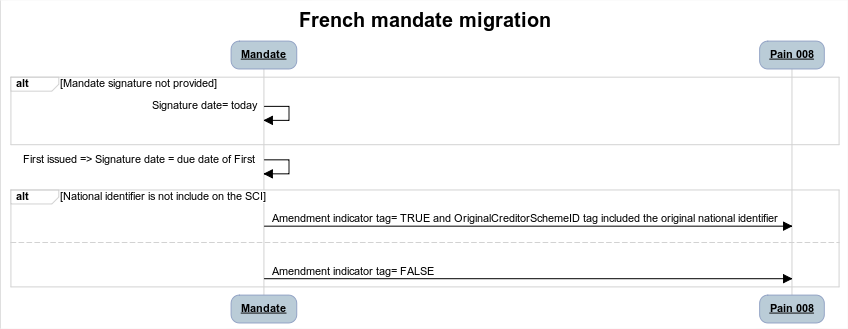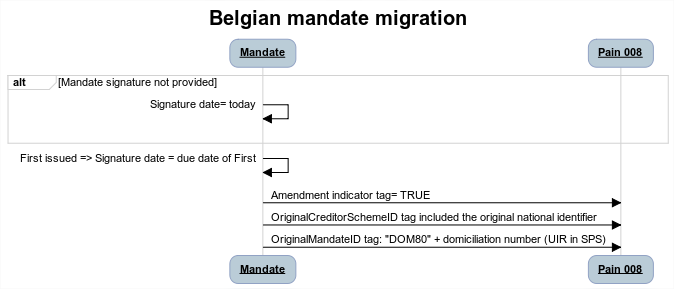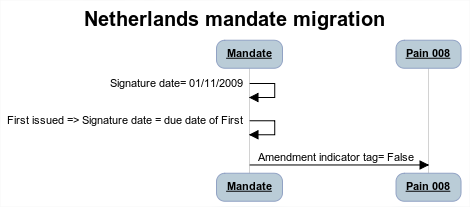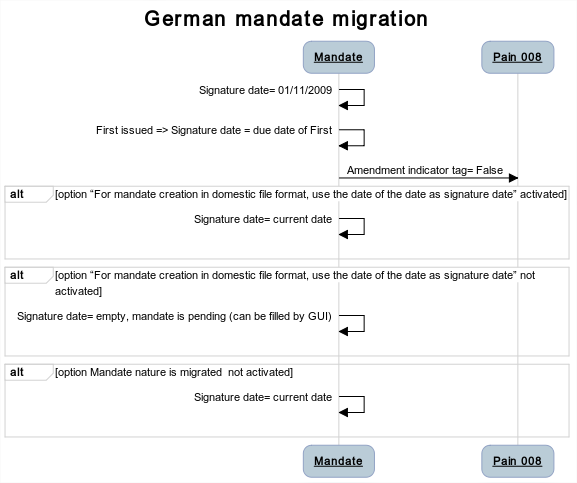Overview
The implementation of SEPA Payment Suite requires the definition of a custom migration procedure by the creditor, enabling the creation of a SEPA mandate database using information relating to direct debit authorizations signed before SEPA.
Amongst other things, this procedure includes:
Determining the SCI from the creditor’s national identifier;
Converting the debtor’s bank details (BBAN to BIC-IBAN);
Generating the unique mandate references from specific creditor information;
Creating links between existing creditor information and the SEPA mandates database that will enable:
-
The creditor to manage their direct debits from a unique known identifier (the UIR and not the UMR),
-
SEPA Payment Suite to enhance the mandatory SEPA data during the generation of SDDs to the banks.
For each country, the migration procedure is customized according to national rules (BBAN, UMR).
The migration procedure is based solely on the file transfer to the SEPA Payment Suite standard format or following the national format used prior to the implementation of SEPA. This second option should be used with caution, as not all the data from a SEPA mandate is present in the old national format. The migration process for French direct debits is described in detail in Appendix A of this document.
By default, a pre-SEPA mandate properly integrated in SEPA Payment Suite bears an “Active” status. However, a creditor may wish to make sure of the proper data migration of the mandate, in which case a parameter is used to position the correctly integrated mandates in “Waiting for creditor validation” status. The validation process remains identical to that of a non-migrated mandate (See Double validation of mandate).
The migration of a B2B mandate is impossible.
In the case the creditor creates a mandate via a mandate file and asked to create a B2B pre SEPA mandate: The mandate is created as a B2B SEPA mandate. The mandate status is “Pending”, the signature date is not added.
In the case the creditor creates a mandate via a domestic transaction file and asks to create a pre SEPA mandate: The mandate is always created as a B2C pre-SEPA mandate.
Difference between Migrated Pre SEPA Mandate and SEPA Mandate
Management of Pre-SEPA Mandate Stock
The software manages the recovery of pre-SEPA Mandates stock. The creditor can import its migrated mandates stock:
-
From a CSV file using a SPS format, indicating for each mandate if it is migrated
-
From a payment request file (such as CFONB, CSV or SPS-compliant XML format). The creditor can authorize SEPA Payment Suite to create mandates through domestic payments file import. Indeed when the data contained in the payment does not correspond to a known mandate and if the creditor authorized the software to create a new mandate, SEPA Payment Suite will extract data from the mandate of the payment request to create a new mandate.
Rules related to migration
National rules associated to mandate migration are automatically applied by SEPA Payment Suite:
-
The scheme of a migrated mandate is set to “Core”,
-
The signature date is automatically calculated.
The following scheme present the different migration rules for countries:

Figure 3 : French migration rules

Figure 4: Belgian migration rules

Figure 5 : Netherlands migration rules

Figure 6 : German migration rules
Mandate Migration Parameters
Parameters to manage mandate creation from transaction file
A first parameter “Mandate generation for payment” allows the creditor to choose if he wants to manage its mandates from payment request files; which means that from the transactions file: SDD and mandate can be created.
Only if the first parameter is activated a second parameter is displayed.
This second parameter “process unknown mandates” allows the creditor to indicate whether mandates created via payment request files must be considered as migrated pre-SEPA mandates or as new SEPA mandates.
It will be impossible to import from the same domestic file migrated mandates and new SEPA mandates.
Some domestic transaction files do not include the signature date whereas the signature date is mandatory in SPS to generate SDD on the mandate. In case the creditor chooses to create “SEPA Mandate” from domestic files, he can configure the parameter “For mandate creation in domestic file format, use the date of the day as signature date”. This parameter allows SPS to set the signature date = creation date in case the mandate is created from the domestic file.
General Setting parameters
Either the file is uploaded via the GUI: in this case for each upload, the user chooses if the file contains migrated pre-SEPA mandates or new SEPA mandates.

Figure 7- Setting parameters
The parameter “process unknown mandates” is displayed only if the parameter “Mandate generation for payment” is checked.
The parameter “process unknown mandates” allows two choices:
-
New SEPA Mandate,
-
Pre-SEPA Migrated Mandate.
-
Existing SEPA Mandate (This choice will be available for Cfonb, DTA, Clieop, Norma transaction files).
When the parameter “For mandate creation in domestic file format, use the date of the day as signature date” is checked, SPS adds the signature date on the mandate when the mandate is create form a domestic transaction file which does not include the signature date.
Upload parameters
Either the file is transferred via machine to machine exchange, the creditor must choose in its parameters if the file received will contain migrated Pre SEPA mandates or as new SEPA mandates.
The upload files system is separated according to the kind of the files (transaction, mandate, debtor, return, etc.)

Figure 8 - Upload a transaction file when the parameter “Mandate generation for payment” is checked
For each kind of upload, the user has to select the format of the file he wants to upload.
The format will be selected according to a list of his authorized file formats.
A check will be done between the selected format and the file uploaded in order to avoid that a user upload a non-authorized file format.